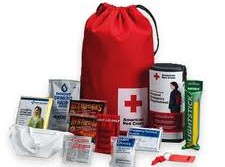General Emergency Kit Items
August 28, 2012 | Posted by adminHOW PEOPLE CAN PREPARE FOR EMERGENCIES
Emergency Preparedness List- By Elizabeth Spiers
Building an Emergency Kit: Checklist

· Water: amounts will vary. Individuals should decide what amount they should store comfortably inside the home and be able to transport to other locations. They should have enough water for three to seven days.
· Food: at least a three-to seven-day supply of non-perishable food
· Flashlight and extra batteries
· First aid kit
· Whistle to signal for help
· Dust mask, bandanna or cotton t-shirt to help filter air
· Moist towelette for sanitation
· Wrench or pliers to turn off utilities
· Can opener for food (if kit contains canned food)
· Plastic sheeting and duct tape: to shelter in place
· Unique family needs: prescription medications, glasses or contact lenses, infant formula or diapers, pet food/supplies, and important family documents
· Plastic for important family documents (Another option is to scan them on a CD and take the disk with you. You can protect this CD with a password. Keep important family documents in a safe deposit box at your bank.)
· Garbage bags and plastic ties: for personal sanitation
· Extra pair of socks
· Extra cash and credit cards
Items Specifically for Deaf-Blind People:
· Hearing aid or cochlear implant batteries
· Extra hearing aids (if you have them)
· Sunglasses
· Extra pair of glasses and/or other optical aids
· Mobility cane (extra pair if you need/have one)
· Batteries and charger for pagers or cell phones
· Note pad and pen for communication (have dark felt tip pen and high contrast paper handy if you use them)
· Communication cards describing the best way to communicate with you
· Braille communication cards (if you use them)
· Business cards of SSPs, interpreters, service agencies
· Food, water and medicine for guide dogs or other service animals or pets
Source: General Emergency Kit Items: Modified with permission from Christine Seymour, CEPIN/TDI, “Are You Ready?” September 2005, Page 4.
Source: Items Specific for Deaf-Blind People, Mary Polly Easley, Telecommunications Access of North Carolina, North Carolina Division of Services for the Deaf and the Hard of Hearing, North Carolina Department of Health and Human Services.